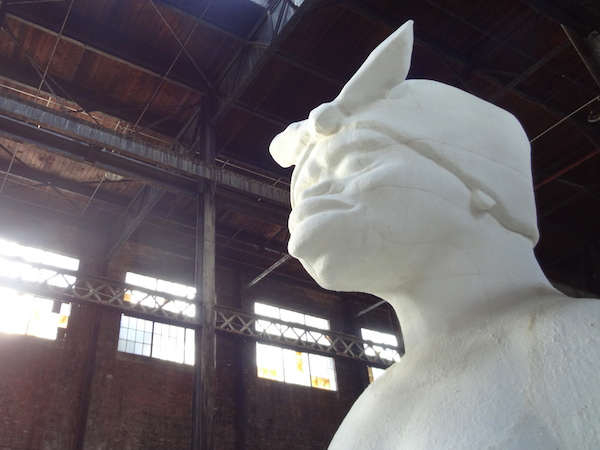Art & Exhibitions
Around the Art World in Six Minutes
From Uruguay's gallery scene to preservation heroes, art news to start your week.

Photo: Benjamin Sutton.
From Uruguay's gallery scene to preservation heroes, art news to start your week.

The Interview: Of all the volunteer “interpreters” at the Domino Sugar Refinery during Kara Walker‘s just-finished Creative Time project “A Subtlety, Or the Marvelous Sugar Baby,” only one was an actual former employee in the plant when it was an active sugar refinery. The Atlantic spoke to Robert Shelton about the 20 years he spent working in the hulking Brooklyn factory and his feelings about its imminent transformation from a post-industrial art space into luxury apartments. “We don’t want luxury apartments,” he says. “Why should someone who has a lot of money come from upstate or from Connecticut and benefit rather than people who have lived there all their life? It has been a long delay because the developers only want to give a small percentage…for regular people like me.”
The Rallying Cry: In an op-ed bemoaning the lack of a Monuments Men–style task force to go around the world safeguarding cultural heritage sites in conflict zones—a piece that veers offensively off-track in a passage implying that the Detroit Institute of Arts’s so-called “grand bargain” is diverting money that would be better spent saving other priceless artifacts elsewhere—the Wall Street Journal‘s Melik Kaylan calls for the creation of a prize rewarding and encouraging acts of heroic cultural preservation.

A wallpaper design by Peggy Angus.
Courtesy: Towner.
The Profile: Peggy Angus, a British artist and designer whose inventive tiles, murals, and wallpaper designs earned her limited recognition in life and have been all but forgotten, are the subject of a new book by James Russell and a new exhibition at Towner on England’s south coast. On the occasion of Angus’s reemergence, the Guardian‘s Rachel Cooke recaps her career and offers some theories to explain Angus’s persistent obscurity. “[M]ale architects were content to use women artists to decorate their buildings, but this didn’t mean they were going to share the credit for a design’s success,” Cooke writes, though that only partly explains it. “She could be really rude to people,” Victoria Angus says. “Absolutely foul. She thought it was unfair, her life. She longed for a wife, for someone to do the cooking so she could get on with her work.”
The Travel Piece: Is Uruguay set to supplant Brazil as the art world’s preferred South American destination? So suggests a New York Times travel feature on the contemporary art gallery scene flourishing on the country’s east coast, particularly in the city of Punta del Este and nearby towns of José Ignacio and Pueblo Garzón. “A few years ago I began to see that Uruguay started moving in a very interesting direction,” says Paris-based dealer Renos Xippas, who just opened a branch of his namesake gallery in the region. “I decided to open a gallery in Punta del Este before someone like Larry Gagosian came and did it.”

Anonymous architect of the Paektusan Academy of Architecture, Silk Co-operative (2011); Commissioned by Nick Bonner, courtesy of the Nick Bonner Collection, Beijing.
Photo: Courtesy Koryo Tours.
The Eye Candy: CNN caught up with Koryo Tours, a Beijing-based company that operates tours in North Korea and is the improbable organizer of the North Korean contribution to South Korea’s Golden Lion-winning pavilion at the 2014 Venice Architecture Biennale. The tourism company asked a worker at the Pyongyang-based Paektusan Architectural Institute to create designs for futuristic, sustainable tourism developments in North Korea. The resulting artworks, currently on display in Venice, have a cartoon-ish, retro-futurist charm about them. “Some people see it as retro and kitsch, while others see it as inventive, fun and with some valid ideas,” says Nick Bonner, who oversaw the project and commissioned the artworks. “It was never intended as anything more than a visual brainstorm—a way to stimulate engagement, ideas and discussion.”
The Extra-Curricular: Researchers at Washington, DC’s George Washington University who were trying to trace the origins of an epileptic woman’s seizures unwittingly demonstrated a theory developed a decade ago by researchers at Seattle’s Allen Institute for Brain Science: that all of the brain’s activities must be coordinated and processed by some particular section of the cranium, which in essence produces the unique set of factors that characterizes human consciousness. This multitasking brain master, the Allen Institute researchers posited, is the claustrum. And by stimulating that section of the epileptic woman’s brain the GWU researchers essentially switched off her consciousness, the New Scientist reports. “When the team zapped the area with high frequency electrical impulses, the woman lost consciousness,” the article explains. “She stopped reading and stared blankly into space, she didn’t respond to auditory or visual commands and her breathing slowed. As soon as the stimulation stopped, she immediately regained consciousness with no memory of the event.”